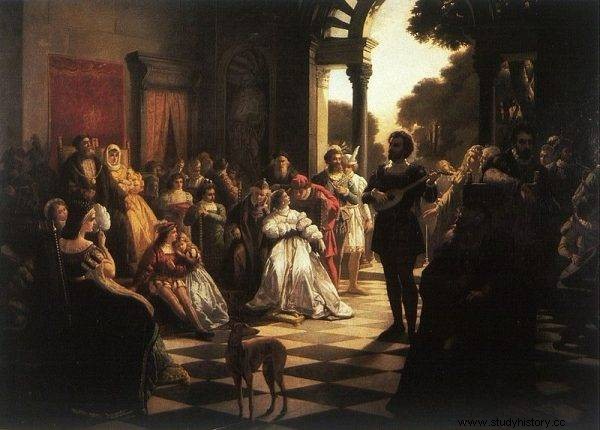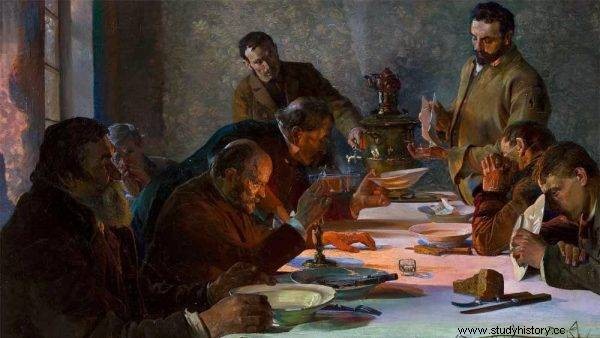"Borscht, from the earliest times Poland's favorite sour soup, usually cooked with beetroot acid (sour beetroot) or bread kvass, considered by old Polish botanists as a medicine" - this is how Zygmunt Gloger wrote in his Old Polish Encyclopedia. Today, this red king of the Christmas Eve table is nothing like his ancestor and is by no means associated with healing properties - and sometimes he can even cause a headache.
According to researchers of culinary history, soups are among the oldest foods eaten by mankind. Probably the primitive man already prepared decoctions or infusions of wild plants or vegetables. Eating such dishes in shells, hollow stones, pieces of wood or on large leaves was certainly not an easy activity, but our ancestor had not faced such challenges.
Anyway, what is the progress of civilization for? As time went on, clay pots appeared, so eating soups became less of a hassle and gained popularity. Today we know that they were enjoyed by the peoples of Mesopotamia, Egypt, and also Greece and Rome. From here it is only a step to… spreading soups all over Europe.
The first soups in Poland are mentioned in the 13th century. Initially, this novelty in the Polish menu was called soups or brioche. As it is a relatively cheap and filling meal, it was eaten by all classes of society. Those cooked on the basis of groats and legumes were enjoyed by the wealthy, and those who were not spilled used lebioda, nettle, sorrel and borscht. At that time, however, the soup, now associated with the Polish Christmas Eve, had little to do with the ruby decoration of the Christmas table.
Borscht has many names
Initially, they enjoyed the soup on the borscht ( Heracleum sphondylium ). Its sliced stems and leaves quickly fermented in the water. As a result, a sour drink was obtained, which was cooked on a topping called borscht. And as a doctor from Lviv wrote: "A Slav becomes sad even if there are no sour food and drinks available" . A career in front of sour cream has opened.
Usually eaten in a fasting form, it was also seasoned with eggs, groats, meat or fish. The popularity of borscht is evidenced by the fact that its admirer was King Władysław Warneńczyk. Perhaps, to sweeten his longing for Poland, as the ruler of Bohemia and Hungary, he had it prepared regularly.

King Władysław Warneńczyk was a great fan of borscht (the picture shows the baptism of a Varna in 1425 in a painting by Jan Matejko).
But even the most sophisticated palates needed new sensations. So gradually the sour greens soup began to go out of date. On the other hand, from the mid-17th century, wheat bran or rye flour was used more and more often instead of cooking borscht from borscht. Thus, the valued sour taste was also obtained, and the old Polish menu was enriched with a new dish - with time called borscht or sour rye soup. The culinary novelty quickly gained recognition, because after such borscht "the person stays light and feels like eating for other dishes".
Borscht at that time seemed to be a graceful object of culinary experiments. This is because Stanisław Czerniecki, the chef of the Lubomirski family, in the first cookbook written in Polish from 1682, "Compendium ferculorum or collecting dishes", included recipes for sour soups in the chapter on cooking milk dishes, pates, cakes and cakes. The royal borscht served by him was a fish soup based on rye leaven, another one was more like an egg brownie whitened with yolks and butter and served with hard-boiled eggs, the third was a herring soup and the fourth was a bouillon thickened with yolks and acidified lemon juice.
It might seem that such soups will rule on Polish tables for a long time and undivided. However, soon they had to face the red competitor.
Bura plant
It is known that beetroot ( Beta vulgaris ) Were already known in ancient Babylonia, Greece and Rome. However, the first mention of their cultivation in Poland comes from the list of plants grown in the botanical garden of King Jan Kazimierz. Historians also suggest that beetroot appeared in our native herbarium during the Renaissance thanks to Queen Bona.
The red and fleshy root of the new plant seemed to be just waiting to be used in the kitchen. Initially, the beetroot (that was what the beet was called then) was baked. In "The Life of a Good Man" by Mikołaj Rej, we even find the following recipe:"Now, after boiling the beetroots in the oven and roasting them well, cool them well, cut them into the plates, arrange them into a cup (barrel), use horseradish, which, after crucifying them, toss [...]" .

Historians also suggest that beetroot appeared in our native herbarium during the Renaissance thanks to Queen Bona.
The aforementioned passion of the Slavs for all kinds of silage meant that the beets were also fermented. The very idea of pickling them might have come from the habit of putting them in sauerkraut to give it a nice color. As it turns out, Rej, invaluable in this topic, also gives us such a tip, writing, among others:
[...] trim the cabbage separately, turn one of the beans on it, cut the heads in half, arrange it, arrange the beetroots, put a dill in it; then it will be both tasty and drunk […].
From here it was just a step away to cook the sour beetroots by trial and error. And since during cooking they discolored an uninteresting dull color, it was natural, say experts on the subject, that the new dish was called beets . Soon its name changed to the name of the plant itself. On the other hand, the soup made on the basis of pickled beetroot broth was called borscht (the one made from borscht). Anyway, the new dish was to your liking and set off to conquer the peasant and noble tables.
Beet pickling has become a kind of national tradition. As Zygmunt Gloger wrote:"For beetroot kvass, there was always a separate wooden vessel in every Polish house in the countryside, both small and noble," to which further portions of beetroot were added. On the other hand, "if it happened that there was someone in the village who did not have beets for the winter, and he would come to the court kitchen with a pot in which acid was poured for him".
The beetroot leaven was used for red borscht with dumplings and a pipe (beef marrow), whitened with sausage, pure or fasted with groats and mushrooms. It became a soup for all occasions, because it was eaten for breakfast after all-night dancing or as the only midday meal on Christmas Eve. And here's an interesting thing - for a very long time borscht was not a Christmas Eve dish. Paul Tremo, the court chef of Stanisław August Poniatowski, cooked the king's ... almond soup on Christmas Eve. Only with time did borscht find a prominent place among the dishes served on this special night.
However, in many regions of Poland, for example in Silesia, borscht never became the king of the Christmas Eve table. It is known, however, that red borscht was enjoyed by guests of the famous Thursday dinners, and Juliusz Słowacki mentioned it among the dishes served during the Easter season at the Czartoryski princes in 1832.
For fever, hangover and… shirts
Szymon Syreński, a 17th-century doctor and botanist, wrote about borscht:“Useful to the medicine and to the table, it is very tasty. But the root is more useful only for medicine, and the leaves for dishes […] ”. Therefore, our ancestors appreciated not only the taste of borscht - both green and red - but also its impact on the health of the consumer. It was already written a century earlier that "when borscht is made in Polish, it is good to drink it in fever [...]".
In his arguments, the aforementioned Syreński also emphasized that borscht "relieves thirst after drinking, brewed, whatever you eat ... also raw sour, drinking in fever is good. The juice squeezed from borscht stems was also used as a medicine against epilepsy and bloody diarrhea. On the other hand, the fruit was used in the prevention of spasms and hysteria, and the decoction of borscht leaves had a beneficial effect on hair - especially children's hair.

Borscht did not immediately become a Christmas Eve dish (in the illustration of Jacek Malczewski's painting "Christmas Eve in Siberia").
The recommendations of the old Polish medical art were confirmed in the 19th century by Zygmunt Gloger, who wrote about medical advice to give "patients pure, unsalted borscht as relieving fever." After a binge, and especially after a drink, it is equally welcome. " He also recalled "how all those suffering from sore throats received rinsing of beetroot acid and unleavened honey in the court, which strangely helped everyone."
The influence of pickled beetroot juice on proper interpersonal relations was also appreciated. Well, in an 18th-century source we find a note that:"After eating garlic, you are disgusted with the stench of garlic from your mouth." A real golden mean for almost everything. Exactly - almost.
For those who see only qualities in beetroot borscht would be wrong. This tasty and healthy soup has one, but a serious disadvantage. No matter how we think, "eaten with a spoon from a deep plate, it cannot resist the temptation not to leave traces in the form of tiny pink dots, preferably on the white starched busts of tailcoat shirts" - wrote the unparalleled promoter of Polish cuisine Nela Rubinstein, wife of the great pianist and great gourmet at the same time. Today, it is true that tailcoat shirts are rarely found, but the red king of the Christmas Eve table can also leave his mark on those currently in use, giving many of the guests a headache.
The quotes are in the original version.
